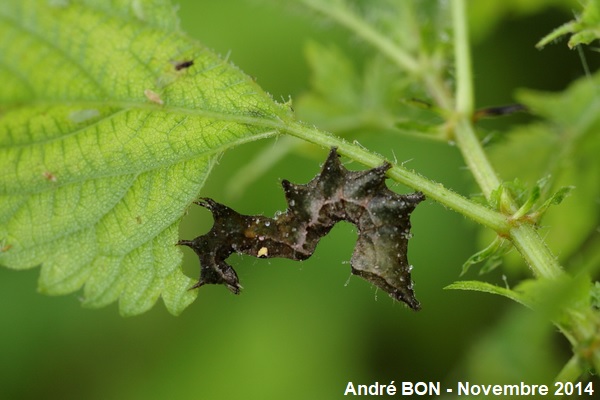

| Dark Spectacle (Abrostola triplasia (Linnaeus, 1758)) |


|
|
Scientific name: Abrostola triplasia (Linnaeus, 1758) Common name: Dark Spectacle French name: Plusie à lunettes Order: Lepidoptera Suborder: Heterocera Family: Noctuidae Subfamily: Plusiinae Wingspan: 28-32 mm. Biotope: Waste lands, woodland edges and other habitats where the host plants grow. Geographic area: Palaearctic region but missing in hot and dry areas. Flight time: Mid-April to October. Number of generations : 2 Caterpillar: The head is black with a central white dash or white markings on the upper side, or green with black markings on the lateral sides. The body is green, blackish or purplish brown with abdominal segments appearing bloated, in particular the second one. There can be diagonal stripes on abdominal segments 2 to 7. The green form bears a dark dorsal line with brownish green dorsal patches on abdominal segments 1 and 2, and one yellow sub-dorsal spot on abdominal segment 1 and sometimes on abdominal segment 2. The blackish or purplish brown forms are speckled grey and pinkish on the upper side, with dark and unmarked dorsal patches on abdominal segments 1 and 2, and one yellow or whitish sub-dorsal patch on abdominal segment 1. There is a hump on segment 8 with a dark spot at the rear. Host plant: Mainly Nettles (Urtica), but also Hop (Humulus lupulus). |
The Dark Spectacle gets its common name from the pattern located on the front and upper side of the thorax, which resembles a pair of spectacles when viewed from the front side.. The fore wings are blackish grey or brownish grey. The basal area is pale brown to pale reddish brown. It is bordered by a curved chocolate-coloured stripe followed by a thin black line. The submarginal area is crossed by a thin and curved black line followed by a chocolate-coloured stripe. These markings start from the inner side of the wing but disappear in the middle without reaching the costal edge. There is no darker area, compared to the ground colour along the costal edge, between the orbicular and reniform spots. The sub-orbicular spot is very weakly marked, especially on the margin side. The wings are not very contrasted. The Dark Spectacle over winters as a pupa. There is a possible confusion with some similar species. Abrostola asclepiadis shows a rather greyish basal area. The sub-orbicular spot is outlined by a thin black line, especially on the margin side. The wings' colour appears more contrasted. The Spectacle (Abrostola tripartita) clearly shows a darker area between the orbicular and reniform spots. The rectangular-shaped sub-orbicular spot is bordered by lighter-coloured scales. There is a dark patch at the apex of the wing. Abrostola agnorista, which is found in southern Europe, from Romania to the extreme south-east of France, can't be told apart from the Dark Spectacle without a close exam of the genitalia. |
| [To know more about the Dark Spectacle] [Next picture] [Top] |

|
I have observed the black form of the Dark Spectacle's caterpillar on Nettles of course. You can clearly see the yellow sub-dorsal patch of the first abdominal segment. |
| [To know more about the Dark Spectacle] [Previous picture] [Top] |

|
Rear view of the caterpillar. |